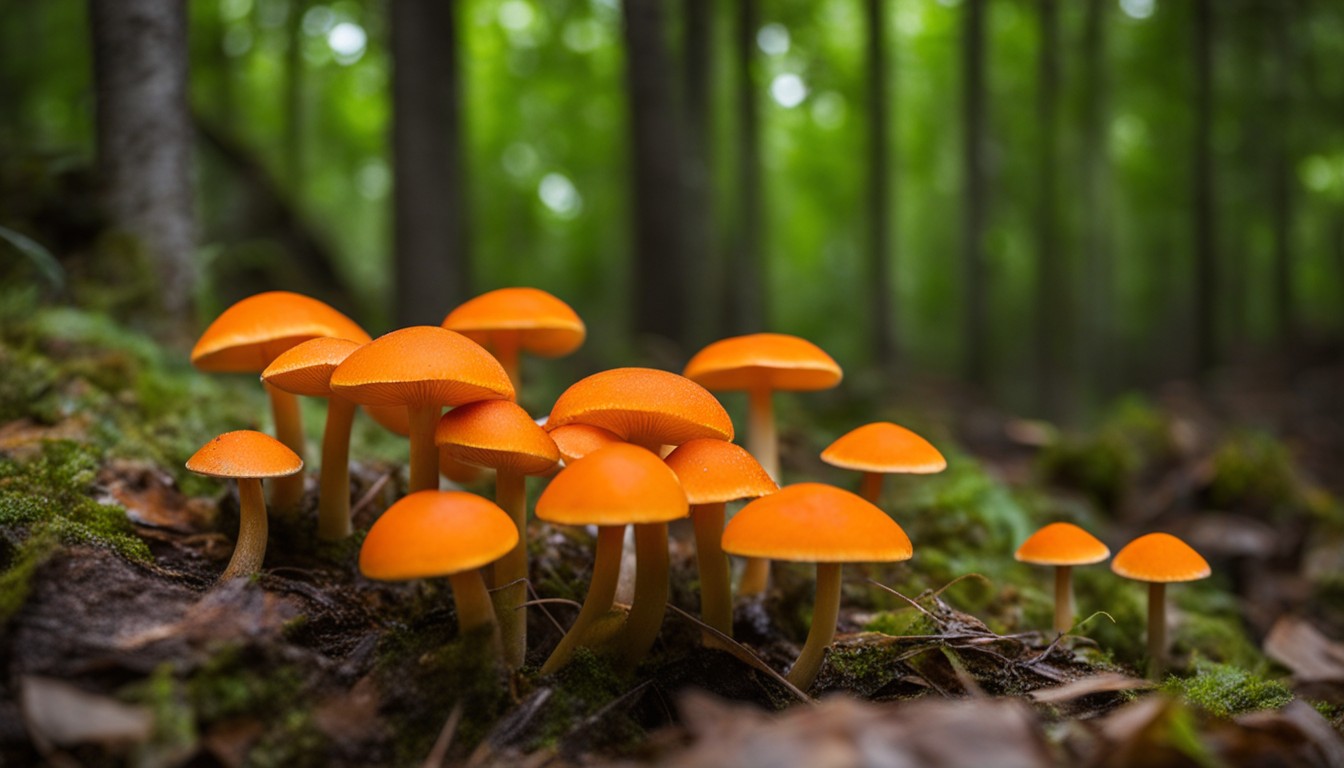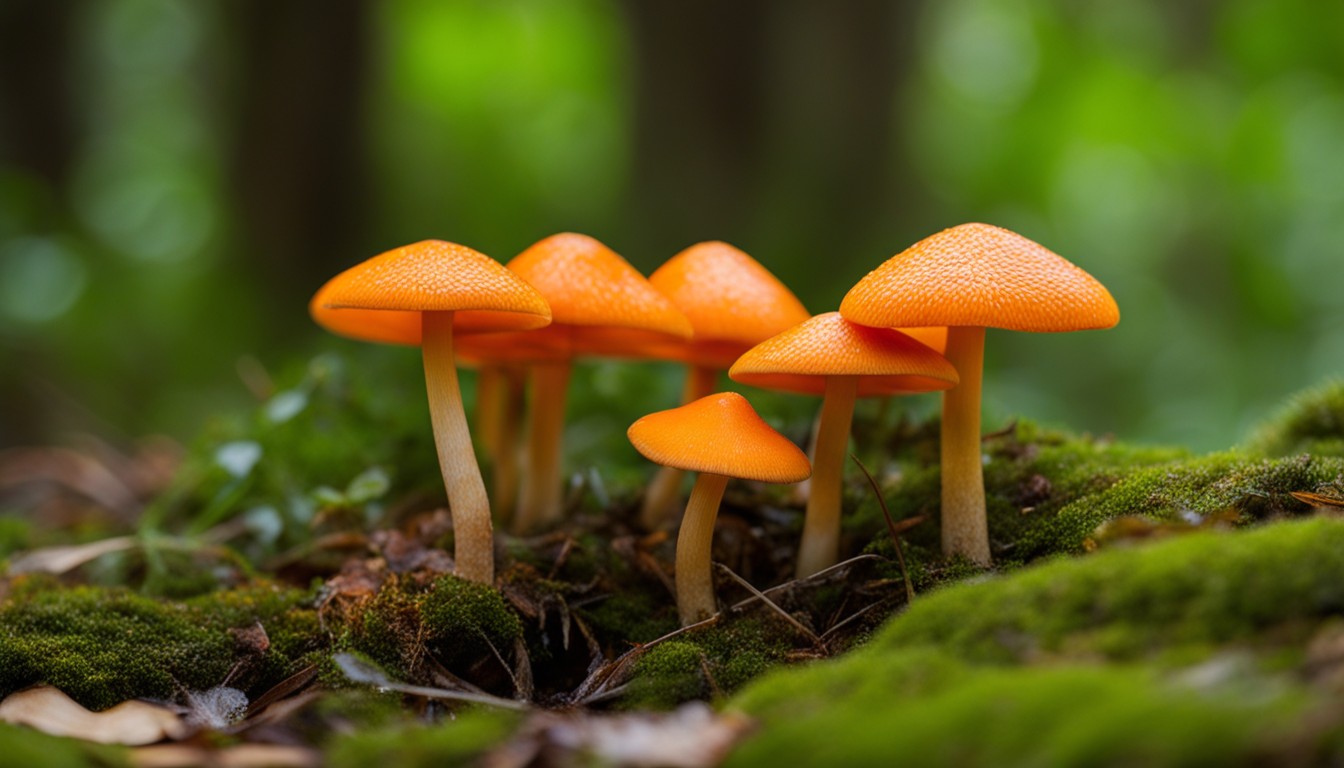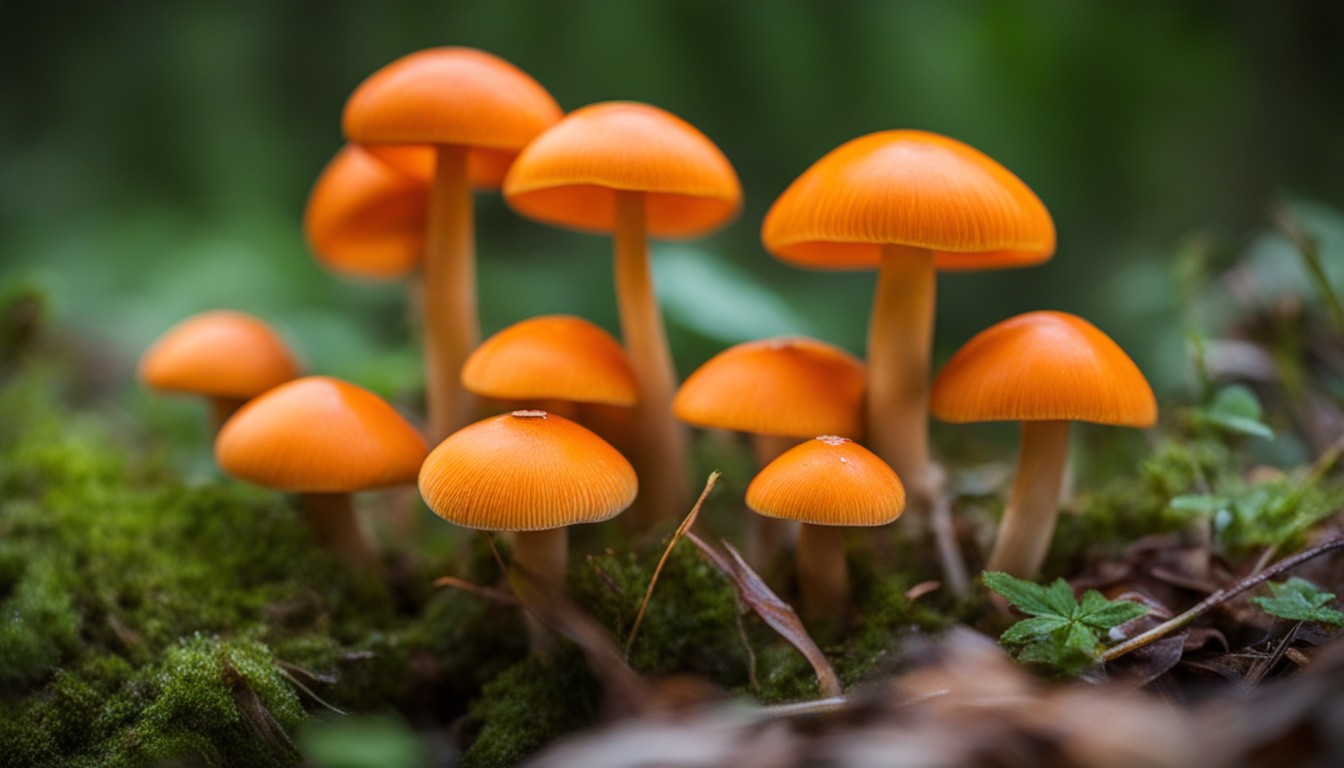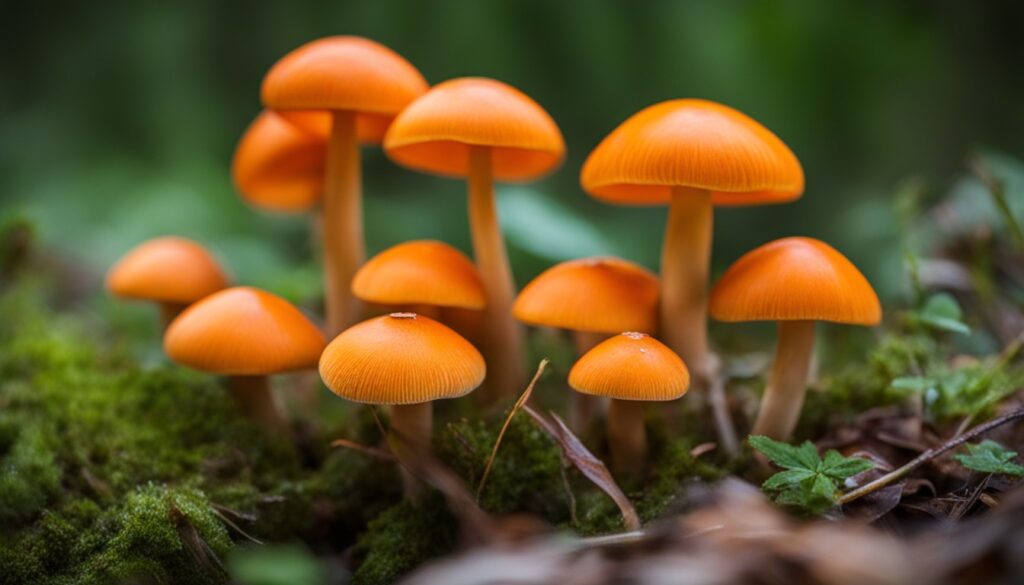Orange mushrooms can be found in many yards, adding a vibrant burst of color to the natural landscape. In this comprehensive guide, we will help you identify and understand these unique fungi, exploring their various shapes, sizes, and features. Whether you’re a curious homeowner or an avid mushroom enthusiast, this article will provide valuable insights into the world of orange mushrooms in your yard. From identification tips to fascinating facts, let’s embark on a journey to uncover the secrets of these captivating fungi.
The Fascinating World of Fungi
A journey into the vast realm of fungi instantly uncovers a striking array of species, each showcasing unique traits and adaptations. Anticipate encountering the astonishing features of fungi, marked by an exciting blend of vibrant colors, intriguing life cycles, and diverse roles in nature’s balance.
What Are Fungi?
Distinguished from similar-looking entities, fungi comprise a unique kingdom of eukaryotic organisms that manifest a complex structure and life cycle. Their cells, which contain nuclei and are walled in chitin, develop into a filamentous structure known as mycelium through spore germination.
Although akin to plants and certain bacteria in appearance, fungi contrast sharply with these organisms. Their primary distinguishing factor lies in the method of nutrition acquisition – fungi, being saprophytic or parasitic organisms, absorb nutrients from their environment through extracellular digestion unlike photosynthetic plants or nitrogen-fixing bacteria.
Role of Fungi in Ecosystems
Fungi play a pivotal role orchestrating the health and nutrient cycling within ecosystems, becoming indispensable contributors towards maintaining balance in nature.
- Providing critical sustenance to plants through mutualistic relationships.
- Breaking down dead organic matter, facilitating nutrient recycling.
- Regulating carbon dioxide levels through sequestration.
- Assisting in soil formation and prevention of soil erosion.
- Maintaining biodiversity by serving as primary decomposers.
Why Study Fungi?
Mycology, the study of fungi, has wide-ranging impacts across various fields. Insights from fungal biology enrich agriculture, medicine, and environmental sciences, offering potential solutions from pathogen control, biofuel production, to pollutant cleansing.
Mycology, spanning agriculture to medicine, empowerment from pathogen control to biofuel production, sheds crucial light on microbial ecosystems, global climate patterns, and even offers pathways for waste management and bioengineering.
Fungi, the world’s great recyclers, demonstrate profound capacities to break down complex organic materials. Academic disciplines from agricultural science to materials engineering find fungal decomposition processes intriguing – making fungi important in both waste management and bioengineering.
Medicine owes much to fungi. Penicillin, the world’s first antibiotic, was derived from Penicillium fungus, marking a revolution in healthcare. Other fungal species deliver compounds useful in cholesterol regulation, immune-suppressant drugs, and cancer treatment.
Fungal research also reveals essential clues about microbial interactions and ecosystems. Fungi play integral roles in soil health, plant symbiosis, and biogeochemical cycles. Decoding fungal complexities thus propels our understanding of broader ecological dynamics, including global climate patterns.
Introduction to Orange Mushrooms

Orange mushrooms are named for their strikingly vibrant hues, ranging from bright citrus to deep pumpkin. They are distinguishable by their stem size, cap shape, spore print and gill colors, exhibiting a variety of pleasing textures and appearances.
Among the common orange mushroom species are the jack-o’-lantern, false saffron, and orange peel. Key features used to differentiate these species include their habitat, unique cap and stem characteristics, and specific spore color and formation.
Characteristics of Orange Mushrooms
Orange mushrooms, because of their vibrant hue, are easily identifiable. However, variation within this captivating group requires us to look closer. Key traits like cap shape, size, and texture, along with spore color, offer crucial clues to distinguishing between species.
The most distinctive, alluring aspect of orange mushrooms is, undoubtedly, their stunning color. From sunset-esque hues to deep amber tones, the palette of these fungi is fascinatingly diverse. The intensity and shade of orange can differ significantly, even among specimens of the same species.
Aside from their electrifying color, orange mushrooms possess unique physical attributes that mark them out. Some might flaunt warty, bulbous caps while others sport slender stems that seemingly defy gravity. Recognizing these traits aids in making accurate identification.
Orange mushrooms also have gills or pores beneath their caps where spores develop. The arrangement, color, and even the space between these gills can vary greatly, providing valuable information towards species identification.
Getting a hold on these intriguing physical traits, alongside understanding their significance, is key for someone interested in orange mushrooms. Even as the attributes differ, the reward remains the same – a deeper insight into the profound complexity and diversity within the world of fungi.
Common Orange Mushroom Species
The world of fungi abounds with myriads of orange mushroom species, each distinct in form, size, and habitat preference. From the widespread Fly Agaric with its distinctive orange-red cap to the intriguing Orange Peel Fungus that mimics a discarded citrus rind, nature’s canvas is magically vivid.
Taking a global viewpoint reveals a great diversity of orange mushrooms. For instance, while North America is home to the Jack-o-Lantern Mushroom, Europe favors the Orange Birch Bolete. Even so, their capacity to enchant remains the same.
At the other end of the spectrum, you find species like the Deceiver, named aptly for its varying colorations. It paints temperate Americas, Europe, and Asia in various shades of orange, epitomizing the diverse range of orange mushrooms around the world.
Identifying Orange Mushrooms

Begin your orange mushroom identification quest by first examining their structural attributes such as cap shape, stem length, and gill pattern. For an accurate distinction, take into account the time of year, local climate, and specific location where you found the mushroom. Always remember, confidence in identification is crucial to avoid toxic varieties.
Being able to differentiate between different species of orange fungi requires an understanding of their varying characteristics. The Fly Agaric, for instance, flaunts a distinct spotted cap, while the Jack O’Lantern mushroom illuminates a captivating bioluminescent glow in the dark. With substantial knowledge and astute observation, you can become adept at distinguishing between these fascinating species.
Visual Recognition and Key Features
The first step in mushroom identification is a careful and thorough visual inspection, which is vital in distinguishing one species from another.
- Check for specific color shades of orange, some might be deeper or more pastel.
- Observe the shape of the cap, whether it’s flat, conical, or bell-shaped.
- Take note of the stalk’s characteristics like length, thickness, and whether or not it has a ring.
- Inspect under the cap for the presence or absence of gills, their color, and spacing.
- Check if there are any surface textures on the cap or stalk, such as scales, warts or sliminess.
- Examine if the mushroom changes color when bruised or cut.
Habitat and Growing Conditions
Orange mushrooms thrive in a variety of habitats but demonstrate a particular affinity for damp, shaded areas with organic matter. Environmental conditions significantly impact their appearance and growth.
- Forested areas with humid, moderate temperature
- Shaded locations with minimal direct sunlight
- Areas abundant in organic matter, such as decomposing leaves and wood
- Mild climates with seasonal rainfall
- Often found growing in clusters on tree stumps and fallen logs
Using Field Guides and Apps for Identification
Field guides and modern smartphone applications are ideal tools for correct identification of orange mushrooms in your yard. They provide a wealth of carefully vetted information and visuals that assist in accurate mushroom identification.
- Consult comprehensive field guides such as ‘National Audubon Society Field Guide to North American Mushrooms’.
- Use smartphone applications like ‘Picture Mushroom’, ‘Mushroom Identification’, and ‘Mushroom identify – Automatic picture recognition’ to snap photos of mushrooms for immediate identification.
- Ensure the field guide or application covers local mushroom species for reliable results.
- Consistently update your apps to get the latest information and improved photo recognition.
- Cross-verify the identification with various resources to avoid misidentification.
The Life Cycle of Orange Mushrooms
Decoding the life cycle of orange mushrooms reveals a fascinating, intricate process, from invisible spores to colorful, umbrella-shaped bodies. These organisms undergo a series of complex transformations, each stage a testament to nature’s remarkable adaptivity and innovation.
The life cycle of an orange mushroom, from airborne spore to mature fungus, is a captivating journey that underscores the resilience and sheer variety of the fungal kingdom. Each stage of growth and development reflects a dynamic interplay of environmental factors and genetic predispositions.
Spore Dispersal Mechanisms
The fascinating realm of orange mushrooms uses myriad techniques for spore dispersal. Each of these dynamic mechanisms play a key part in the spread, survival, and propagation of this vibrant fungal species.
- Spores carried by wind currents to new locations
- Wildlife interactions aid in spore dispersal directly or through their droppings
- Raindrop impact might result in a ‘puff’ of spores
- The attraction of insects to certain mushrooms for spore distribution
Growth and Development Stages
Orange mushrooms, like most fungi, undergo a fascinating growth trajectory. It starts with spore germination, where the spores reach a suitable substrate and begin to grow hyphae. These hyphae become entwined to form mycelium, which is the foundation of mushroom growth. Once the environmental conditions are right (i.e., sufficient moisture, temperature, etc.), the mycelium forms a fruiting body, which we recognize as a mushroom.
The first developmental phase of an orange mushroom, or any mushroom for that matter, is the formation of hyphae from germinating spores. These thread-like structures form an extremely intricate network, known as mycelium, beneath the earth’s surface. The mycelium serves as a feeding network for the fungus, absorbing nutrients from the soil.
Following hyphae formation, mycelium aggregates at certain spots when the environmental conditions are right, paving the way for the next developmental phase – the formation of primordia. Often referred to as ‘pins’, these are the initial stages of a mushroom fruiting body. At this phase, the mushroom starts to take a recognizable form, yet it’s still minute and hard to spot.
As the orange mushroom continues growing, the primordia enter the ‘button’ stage, where the mushroom’s cap starts to separate from the stem. Also, the signature orange pigment becomes more prominent and the mushroom grows rapidly. It’s during this stage that the mushroom is most resilient to adverse environmental conditions.
The final stage features a fully formed, mature mushroom. At this point, the cap has fully opened and the mushroom’s gills, which house millions of spores, are fully exposed. This stage wouldn’t last long, for the mushroom begins to wither and decay shortly after the spores are dispersed. This entire lifecycle, from spore germination to decay, demonstrates the captivating life of orange mushrooms.
Ecological Significance of Orange Mushrooms
Orange mushrooms, striking in color and diverse in form, play a pivotal role in maintaining ecosystem balance. They are instrumental contributors to decaying organic material, a process crucial for nutrient cycling.
Recognize these vibrant fungi not just for their aesthetic appeal, but their silent yet profound support to our ecosystem’s health. Their decomposition efforts regenerate soil fertility and encourage biodiversity, demonstrating nature’s brilliant equilibrium.
Role in Decomposition and Nutrient Cycling
Orange mushrooms excel in the decomposition of organic matter, playing a crucial part in nutrient cycling to enrich soil and boost garden health.
- Accelerate decomposition of leaves, dead plants, and wood debris
- Aid in converting organic matter into fertile soil
- Release critical nutrients into the soil
- Enhance plant growth by improving soil structure and aeration
Interactions with Other Organisms
Mycorrhizal associations between orange fungi and their host plants form a crucial part of the forest ecosystem, assisting in nutrient exchange and promoting plant health. These vibrant mushrooms serve a pivotal role in stabilising the soil, thereby enhancing plant development and growth.
Orange mushrooms also foster biodiversity. By providing a unique habitat and food source for smaller creatures, they contribute to a healthy, balanced ecosystem. Fauna, especially insects and small mammals, are attracted to these fungi, establishing a complex symbiotic relationship that influences the overall health of local habitats.
Toxicity and Edibility of Orange Mushrooms

Navigating the safety spectrum of orange mushrooms in your yard uncovers a world of intrigue. Discerning edible varieties from toxic ones requires knowledge, caution, and respect for these vibrant organisms.
Considering consumption of orange fungi necessitates careful consideration of their edibility factors. Some species are culinary delights, but others, while appealing to the eye, may house toxins that are harmful or even fatal to humans.
Common Toxic Orange Mushrooms to Avoid
Popular in North America, the Jack o’ Lantern mushroom and the Orange Galerina are two frequently encountered toxic orange mushrooms. Their vibrant hue belies a deadly nature that makes identification critical for mushroom enthusiasts.
Attention to details such as a mushroom’s gill patterns, stem characteristics and spore color, can be lifesaving. Especially dangerous is the Orange Galerina, often mistaken for edible species, yet known to contain potent, lethal toxins if ingested.
Edible Orange Mushrooms and Culinary Uses
Famed for their robust color and fantastic taste, a variety of consumable orange mushrooms lend themselves to diverse culinary creations. Striking examples include the Chanterelle and Chicken of the Woods, each offering unique flavor profiles.
The journey from forest to fork is a delicate process. Once positively identified, edible orange mushrooms should be carefully harvested, cleaned, and inspected before entering any kitchen.
Preparation of these fungi highlights their natural flavors. Depending on the species, sautéing, roasting, or grilling can elevate their earthy tones and undertones of fruit or nut, granting gourmet delights.
Orange Mushrooms in Your Yard
Your backyard is likely a vibrant bouquet of biodiversity, often graced by the surprising prevalence of orange mushrooms. These glowing snaps of the natural world, with shades varying from muted tangerines to rich ochres, lend a whimsical charm to American gardens.
The diversity of these orange mushrooms in domestic spaces is substantial. From the common yet elegant Fly Agarics to the more elusive Jack O’Lanterns, yards across America play host to a stunning spectrum of these bright fungi.
Are They Beneficial or Harmful?
Taking center stage in the tussle between the beneficial and harmful aspects of orange mushrooms, it’s key to know that their ecological role depends largely on the species. Some decompose organic matter, releasing vital nutrients into the soil, while others can form beneficial symbiotic relationships with plants. However, certain species may prove harmful if ingested or may cause garden plant disease.
Well-rooted in misconception, orange mushrooms are often unfairly labeled as harmful invaders in our gardens. Their vibrant color can evoke notions of danger, but the reality is that only a minute fraction of these fungi are toxic to humans. Most simply serve their ecological purpose without adverse effect to their surroundings.
That said, it’s always wise to exercise caution around unknown mushroom species, particularly if there are pets or young children around. While most orange mushrooms are harmless to touch, consumption without accurate identification poses serious risk. Always consult with a mycologist or use a reputable identification guide before deciding to interact closely with these strikingly colored funguses.
Tips for Maintaining a Healthy Yard with Orange Mushrooms
Adopting clever gardening strategies can foster a harmonious coexistence with orange mushrooms in your yard. Consider them as friendly neighbors, and undertake mulching and soil aeration that also favors their growth, connecting their benefits to the overall ecosystem of your ground.
Continuous yard maintenance is vital when orange mushrooms are present. Monitor their growth regularly; if excessive, thinning may be necessary to maintain a healthy yard. Remember, their presence signals soil richness – a sign of a vibrant, healthy yard.
Frequently Asked Questions About Orange Mushrooms in My Yard
Find answers to commonly asked questions about the vibrant world of orange mushrooms found in your yard.
What are orange mushrooms, and why do they appear in my yard?
Orange mushrooms belong to a diverse group of fungi known for their striking orange coloration. They can appear in your yard due to various factors such as decaying organic matter, moist conditions, and specific environmental conditions that favor their growth.
Are orange mushrooms in my yard dangerous?
While most orange mushrooms in yards are harmless, it’s essential to exercise caution and avoid consuming them as some species can be toxic. It’s always advisable to appreciate their beauty from a safe distance and avoid ingesting any wild mushrooms unless identified by a qualified mycologist.
How can I identify orange mushrooms in my yard?
To identify orange mushrooms in your yard, observe their distinctive features such as color, shape, size, and texture. Consulting a field guide or seeking assistance from experienced mycologists can help you accurately classify the species.
Do orange mushrooms serve any ecological purpose?
Yes, orange mushrooms play a crucial role in the ecosystem as decomposers. They help break down organic matter, recycling nutrients back into the soil and facilitating the health and vitality of the surrounding plant life.
Can I remove orange mushrooms from my yard?
While it’s possible to remove orange mushrooms from your yard, it’s important to remember that these fungi contribute to the natural processes of decay and nutrient cycling. Instead of removing them, consider appreciating their beauty and ensuring they are not in direct contact with edible plants or areas where children or pets frequent.
How can I promote the growth of orange mushrooms in my yard?
To encourage the growth of orange mushrooms in your yard, create a conducive environment by providing adequate moisture, organic matter, and shade. However, it’s important to note that mushroom growth is unpredictable, and specific species may require specialized conditions to thrive.
Are there any rare or unique species of orange mushrooms that I might find in my yard?
There is a wide array of orange mushroom species, some of which may be relatively rare or unique. Keeping a keen eye on your yard’s mushroom population and documenting any unusual findings can help contribute to the understanding and appreciation of these fascinating fungi.
Can I use orange mushrooms for culinary purposes?
It is generally not recommended to use wild mushrooms, including orange mushrooms, for culinary purposes unless they are positively identified as edible species by an expert mycologist. Mistaking toxic mushrooms for edible ones can have severe health consequences, so it is best to exercise caution and rely on professional guidance.
How can I learn more about orange mushrooms?
To enhance your knowledge and appreciation of orange mushrooms, consider joining local mycology groups, attending mushroom forays, or consulting reputable books, websites, and educational resources dedicated to the fascinating world of fungi.
Remember to treat wild mushrooms with respect and caution and always prioritize your safety when engaging with them.
Conclusion
Grasping the full cycle, characteristics, and impacts of orange mushrooms bring about a comprehensive understanding of these bright fungi in your yard. Embrace their vibrancy and diversity while maintaining a healthy yard.
- Caring for your yard amidst the presence of mushrooms
- Appreciating the aesthetic impact of orange mushrooms
- Monitoring & managing the mushroom population
- Performing periodic checks for toxic species
- Using field guides & apps for species identification
- Understanding the ecological role of fungi in your yard

